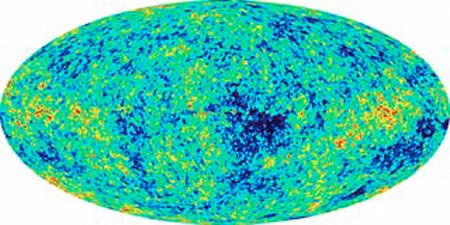NASA today unveiled the first detailed full-sky map of the cosmic microwave background, the microwave “echo” of the Big Bang. Scientists created the map using data collected by the Wilkinson Microwave Anisotropy Probe satellite (WMAP) over a 12-month period. The results provide further support for the inflationary Big Bang model of the universe and reveal when the first generation of stars was created.

The photons in the cosmic microwave background were created in the Big Bang and then continually scattered by free electrons in the early universe. They were released when the universe had expanded and cooled enough to allow these electrons to combine with protons and form hydrogen atoms. The properties of the photons – which have been stretched to microwave wavelengths by the expansion of the universe — can therefore be used to study the universe at this “time of last scattering”.
A number of experiments have been carried out on the ground and in balloons to study the tiny temperature fluctuations in the microwave background caused by variations in the density of the early universe. WMAP, however, has been able to study these fluctuations in far more detail. And unlike previous experiments, it can record images of the microwave background across the whole sky.
“We’ve captured the infant universe in sharp focus, and from this portrait we can now describe the universe with unprecedented accuracy,” says WMAP Principal Investigator Charles L. Bennett of the Goddard Space Flight Center. “The data are solid, a real gold mine.”
The data indicate that the time of last scattering occurred about 380,000 years after the Big Bang and that the Universe is now 13.7 billion years old, give or take 1%. They also reveal that the earliest stars in the universe were created just 200 million years after the Big Bang.
In addition, the results support the idea that the universe underwent a period of rapid expansion when it was very young and that its geometry is flat. The data show that 4% of the universe is ordinary matter, 23% dark matter and 73% dark energy. The NASA researchers say that this dark energy is more likely to resemble Einstein’s “cosmological constant” than a negative-pressure energy field called “quintessence”, but they do not rule out quintessence.
WMAP is named in honour of David Wilkinson of Princeton University, a project team member who died in September last year. The satellite was launched in June 2001 and now orbits the Lagrange Point, a million miles from Earth. It will continue to observe the cosmic microwave background for another three years.



